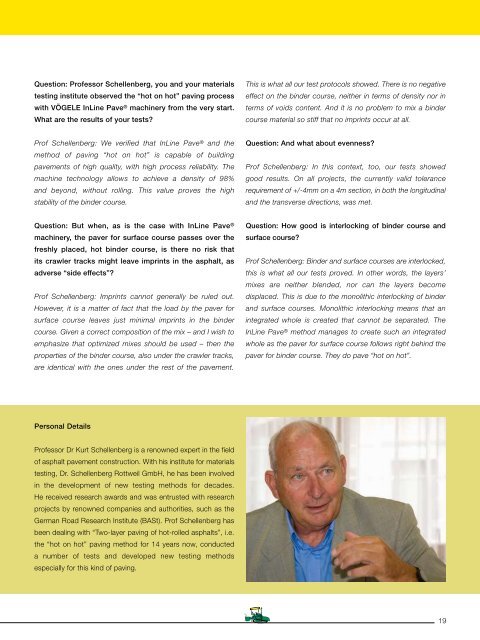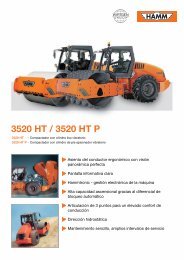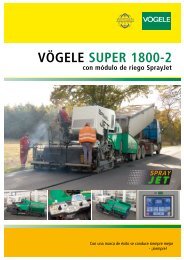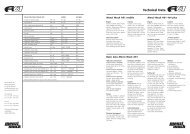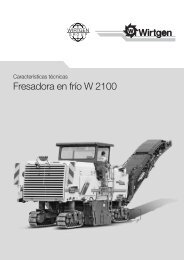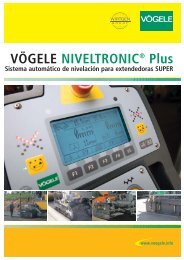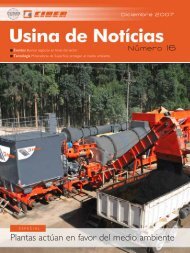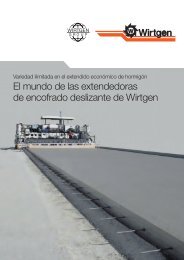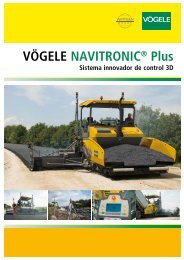InLine Pave® – The Proven Paving Method Offered by ... - Resansil
InLine Pave® – The Proven Paving Method Offered by ... - Resansil
InLine Pave® – The Proven Paving Method Offered by ... - Resansil
You also want an ePaper? Increase the reach of your titles
YUMPU automatically turns print PDFs into web optimized ePapers that Google loves.
Question: Professor Schellenberg, you and your materialstesting institute observed the “hot on hot” paving processwith VÖGELE <strong>InLine</strong> Pave ® machinery from the very start.What are the results of your tests?This is what all our test protocols showed. <strong>The</strong>re is no negativeeffect on the binder course, neither in terms of density nor interms of voids content. And it is no problem to mix a bindercourse material so stiff that no imprints occur at all.Prof Schellenberg: We verified that <strong>InLine</strong> Pave ® and themethod of paving “hot on hot” is capable of buildingpavements of high quality, with high process reliability. <strong>The</strong>machine technology allows to achieve a density of 98%and beyond, without rolling. This value proves the highstability of the binder course.Question: And what about evenness?Prof Schellenberg: In this context, too, our tests showedgood results. On all projects, the currently valid tolerancerequirement of +/-4mm on a 4m section, in both the longitudinaland the transverse directions, was met.Question: But when, as is the case with <strong>InLine</strong> Pave ®machinery, the paver for surface course passes over thefreshly placed, hot binder course, is there no risk thatits crawler tracks might leave imprints in the asphalt, asadverse “side effects”?Prof Schellenberg: Imprints cannot generally be ruled out.However, it is a matter of fact that the load <strong>by</strong> the paver forsurface course leaves just minimal imprints in the bindercourse. Given a correct composition of the mix <strong>–</strong> and I wish toemphasize that optimized mixes should be used <strong>–</strong> then theproperties of the binder course, also under the crawler tracks,are identical with the ones under the rest of the pavement.Question: How good is interlocking of binder course andsurface course?Prof Schellenberg: Binder and surface courses are interlocked,this is what all our tests proved. In other words, the layers’mixes are neither blended, nor can the layers becomedisplaced. This is due to the monolithic interlocking of binderand surface courses. Monolithic interlocking means that anintegrated whole is created that cannot be separated. <strong>The</strong><strong>InLine</strong> Pave ® method manages to create such an integratedwhole as the paver for surface course follows right behind thepaver for binder course. <strong>The</strong>y do pave “hot on hot”.Personal DetailsProfessor Dr Kurt Schellenberg is a renowned expert in the fieldof asphalt pavement construction. With his institute for materialstesting, Dr. Schellenberg Rottweil GmbH, he has been involvedin the development of new testing methods for decades.He received research awards and was entrusted with researchprojects <strong>by</strong> renowned companies and authorities, such as theGerman Road Research Institute (BASt). Prof Schellenberg hasbeen dealing with “Two-layer paving of hot-rolled asphalts”, i.e.the “hot on hot” paving method for 14 years now, conducteda number of tests and developed new testing methodsespecially for this kind of paving.19


